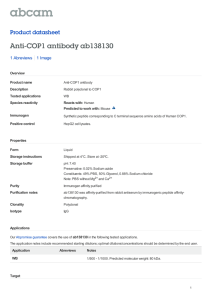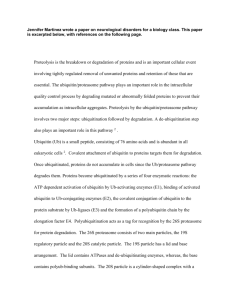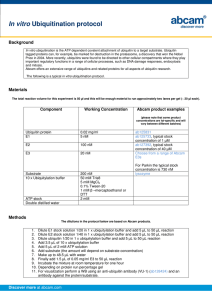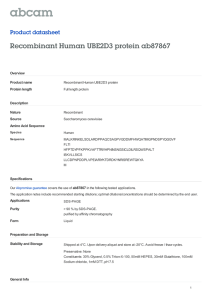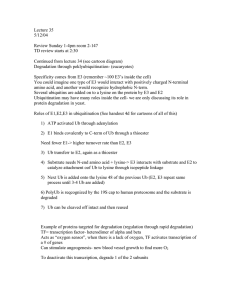Introduction Session 1 and 2 (Ubiquitin, proteasome and human disease)
advertisement
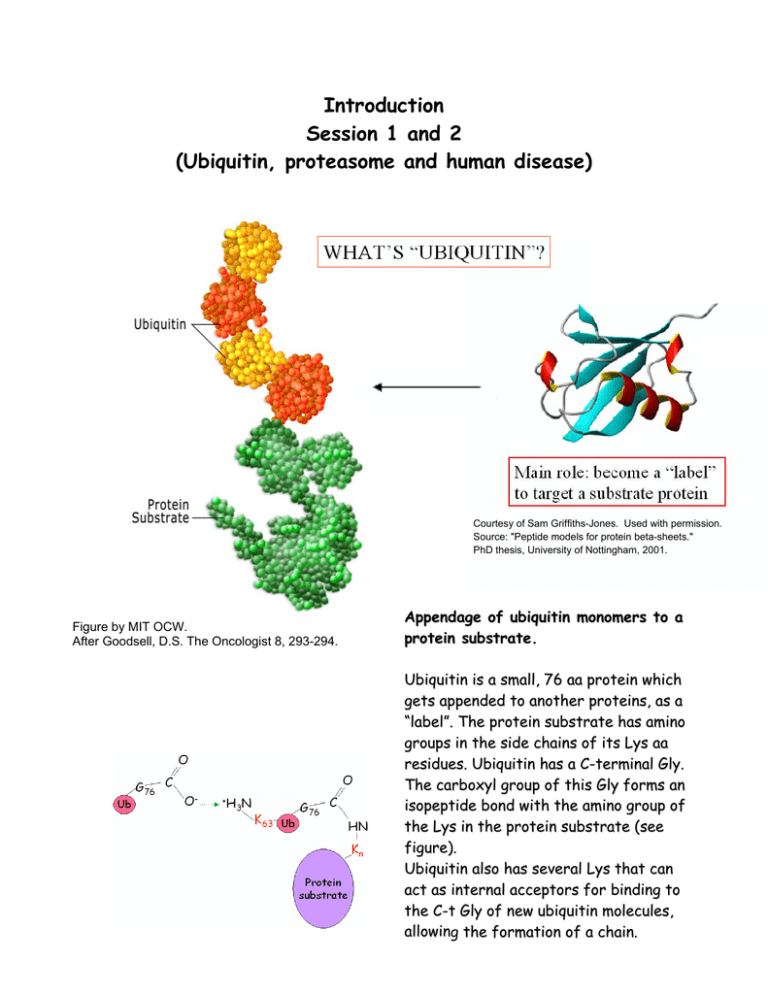
Introduction Session 1 and 2 (Ubiquitin, proteasome and human disease) Courtesy of Sam Griffiths-Jones. Used with permission. Source: "Peptide models for protein beta-sheets." PhD thesis, University of Nottingham, 2001. Figure by MIT OCW. After Goodsell, D.S. The Oncologist 8, 293-294. Appendage of ubiquitin monomers to a protein substrate. Ubiquitin is a small, 76 aa protein which gets appended to another proteins, as a “label”. The protein substrate has amino groups in the side chains of its Lys aa residues. Ubiquitin has a C-terminal Gly. The carboxyl group of this Gly forms an isopeptide bond with the amino group of the Lys in the protein substrate (see figure). Ubiquitin also has several Lys that can act as internal acceptors for binding to the C-t Gly of new ubiquitin molecules, allowing the formation of a chain. DISCOVERY OF THE ROLE OF UBIQUITIN N IN PROTEIN DEGRADATION.. HISTORICAL FACTS.. Courtesy of Sam Griffiths-Jones. Used with permission. Source: "Peptide models for protein beta-sheets." PhD thesis, University of Nottingham, 2001. (1975) Ubiquitin was first isolated by Gideon Goldstein and colleagues from the thymus (reason why it was originally thought to be a thymic hormone). But because it was later found in all tissues and eukaryotic organisms it received the name of UBIQUITIN (for ‘ubiquitous’ protein). (1977) Harris Goldknopf and Ira Busch found a DNA-associated protein that had one C-t but two N-t! The short arm of this Yshaped unusual protein was joined through its C-terminal to the εamino group of an internal Lys of the histone H2A. Margaret Dayhoff soon identified it as Ubiquitin (a protein initially described as free by Goldstein). (1969-1971) Avram Hershko studies regulation of tyrosine aminotransferase by its degradation Æ he found that degradation of the enzyme was arrested by inhibitors of cellular energy production (fluoride, azide) That was the first indication that an as-yet-unknown energydependent proteolytic system must exist. (1971-1980’s) Hershko decided to identify this energy-dependent system responsible for the degradation of proteins, by means of classi cal biochemistry. His aims were: - to reproduce the ATP-dependent protein breakdown in a cell-free system. - to fractionate such system to find the mode of action of its components. (1977) Etlinger and Goldberg discovered an ATP-dependent proteolytic system occurring in reticulocytes (red blood cells). Therefore, Hershko, helped by his grad student Aron ciechanover and Irwin Rose (Fox Chase cancer Center, Philadelphia) decided to isolate the ATPdependent proteolytic system from these cells. • Reticulocyte lysates were fractionated on DEAE-cellulose (anionic exchange chromatography) into two crude fractions: Æ Fxn1(not adsorbed), with most of the hemoglobin . Æ Fxn2, proteins adsorbed to the resin and eluted with high salt. • Fxn2 had lost most of the ATP-dependent proteolytic activity and only was restored when combining back Fxn1 with 2. •The active component in Fxn1 was isolated in basis of its high stability upon heat treatment: APF-1, for ATP-dependent proteolysis factor 1. …possible activator or regulatory subunit of other component/s of the system?? •Radiolabeling APF-1 they saw substantial ATP-dependent binding to high-molecular weight proteins (gel filtration chromatography). • Interaction extremely stable in the presence of conditions that disrupt non- covalent interactions: interaction should be covalent (peptidic or amidic linkage). …APF-1 interacting not with an active component of the proteolytic system but with protein substrates?? • By using a good substrate for ATP-dependent proteolysis, lysozyme, they found: 1) that similar high-molecular weight derivatives were for med when 125I-labeled APF-1 was incubated with unlabeled lysozyme than when 125I-labeled lysozyme was incubated with unlabeled APF-1. 2) analysis of the ratio of radiactivity in APF-1 and lysozyme indicated that the various derivatives consisted of increasing numbers of APF-1 molecules linked to one molecule of lysozyme. (Hershko et al., 1980) Courtesy of A. Hershko. Used with permission of the author. Source: Figure 1 in Hershko et al. "Proposed role of ATP in protein breakdown: conjugation of protein with multiple chains of the polypeptide of ATP-dependent proteolysis." PNAS 1980 April; 77(4): 1783–1786. (Model of action proposed byy Hershko et al., 1980)) Courtesy of A. Hershko. Used with permission of the author. Source: Figure 6 in Hershko et al. "Proposed role of ATP in protein breakdown: conjugation of protein with multiple chains of the polypeptide of ATP-dependent proteolysis." PNAS 1980 April; 77(4): 1783–1786. Several molecules of APF-1 linked to ε-amino groups of the protein substrate by an APF-1-protein amide synthetase (step1). Proteins ligated to several APF-1 are broken down by a specific protease that recognizes such conjugates (step 3). The protein is broken down to free amino acids and to APF-1 still linked by isopeptide linkage to a lysine or a small peptide, APF-1-X. Finally, free APF-1 would be released for re-use by specific amidase-isopeptidase (step 4) . A hypothetical ‘correcting’ isopeptidase would release free APF-1 and substrate protein from erroneous ligations (editing activity; step 2). Short after Hershko’s model proposal, Keith Wilkinson and Arthur Haas (pot-doctoral fellows in Irwin Rose’s lab) indicated that APF-1 was indeed UBIQUITIN. Ubiquitin proteolytic pathway y Courtesy of Annual Reviews. Used with permission. Source: Figure 1A in Hershko A, Ciechanover A. The ubiquitin system. Annu Rev Biochem. 1998;67:425-79. A: Conjugation of ubiquitin to the target substrate Image removed due to copyright considerations. See Figure 1 in Ciechanover A, Orian A, Schwartz AL. "Ubiquitin-mediated proteolysis: biological regulation via destruction." Bioessays. 2000 May; 22 (5): 442-51. E1: Ub-activating enzyme E2: Ub-conjugating enzyme; Ubc’s E3: Ub-ligase B: Degradation of the polyubiquitinated substrate by the 26S proteasome complex and Ub recycling by deubiquitinating enzymes (Ub C-terminal hydrolases, DUBs or UCH’s) (1980’s) Hershko and Ciechanover purified the components of the first part of the reaction (APF-1-protein amide synthetase): E1, E2 and E3 enzymes, by ‘covalent’ affinity chromatography over immobilized Ub. The ‘protease’ step was further clarified with the characterization and purification of the 26 proteasome complex, by Martin Rechsteiner and colleagues (1986). It was first thought that multiple ubiquitin attached to different Lys sites in the substrate protein but Hershko (1985) and then Alexander Varshavsky and colleagues (1989) demonstrated that a single polyubiquitin chain could be form through attachment to a single internal Lys residue. Attachment of subsequent Ub to the first one occurs through linkages of the Gly C-t of the next Ub to specific lysines present in the precedent Ub. Poly-ubiquitin chains might have different roles depending on the Lys utilized: K48 Æ recognition by proteasome K63 Æ signal for traffic and degradation in the lysosome, vacuole; subunit selectivity K29, K6, etc.. First evidence showing that ubiquitin constitutes a signal for protein degradation in vivo (Hershko lab; 1982): immunochemical analysis of Ub adducts in cells Æ by using anti-Ub Abs they saw that, after incubation of cells in the presence of aa analogs the resulting abnormal proteins were short-lived and their rapid degradation was accompanied by a transient increase in Ub adducts. But the strongest confirmation came with Alexander Varshavsky’s work. UBIQUITIN CONJUGATION REQUIRED FOR PROTEIN DEGRADATION IN VIVO (first evidence through the studies carried out by Alexander Varshavsky, Dan Finley and Aaron Ciechanover) Varshavsky studied chromosome structure and regulation of gene expression and came to Boston in the fall of 1977 where, a month later, became a faculty member in the Biology Department here at MIT. He became interested in the role of protein degradation in gene regulation and expression at the light of Hershko’s and Wilkinson’s experiments (showing that the ATP-dependent proteolytic factor 1, was ubiquitin). Considering that he already knew that Ub had been found attached to histones, he became very excited when in 1980 he read a paper, by Yamada and coll. that described a conditionally lethal, temperature sensitive mouse cell line called ts85 (they had seen that in this cell line at restrictive temperature a nuclear protein disappeared and Varshavsky confirmed it was UbH2A). ÆDan Finley, from his lab, and A. Ciechanover helped him to study ts85 and saw that cells were arrested in S/G2 phase of cell division cycle and had induced synthesis of heat shock proteins at non permi ssive temperature. They found that ts85 mouse cells had a temperature-sensitive Ub-activating enzyme (E1) and that these cells stopped degrading the bulk of their normally short-lived proteins at the nonpermissive temperature. Later studies (by Hunt and coll.), with rapidly dividing fertilized clam eggs, led to the discovery of CYCLINS and in 1984 Varshavsky proposed that cyclins were degraded at the exit from mitosis by the ubiquitin system. Stress (Radiation) Ubiquitination Glucocorticoids Mdm2 p53 Bcl-2 Survival Receptor Receptor Ubiquitination Ubiquitination Death Receptor Mitochondrion Ubiquitination cFlip NFxB IxB Ubiquitination Smac/Diablo Cytochrome c Omi Ubiquitination IxB ub ub ub ub ub Degradation IAPs Ubiquitination NFxB Caspase-Dependent Apoptosis Pathway Figure by MIT OCW. After Yang and Xu, "Regulation of apoptosis: the ubiquitous way." FASEB J 17 (2003) 790-799. Figure by MIT OCW. Image removed for copyright considerations. Source: Figure 5 in Muratani M, W. P. Tansey. "How the Ubiquitin-proteasome System Controls Transcription." Nat Rev Mol Cell Biol. 4, no. 3 (Mar 2003):192-201. How are the substrates recognized by the E3s? Image removed due to copyright considerations. See Figure 2 in Ciechanover A. et al. "Ubiquitin-mediated proteolysis: biological regulation via destruction." Bioessays. 2000 May; 22(5): 442-51. “N-End Rule” Discovery y Hershko and Ciechanover saw a discrepancy while attempting to purify APF-1 (Ub): the preparation had a high dry-weight to low proteincontent ratio. Was APF-1 a ribonucleoprotein?? When they treated the preparation with RNase A this abrogated the degradation of BSA me diated by APF-1, although not that of lysozyme. They later found the weight to protein content discrepancy was in fact caused by the protein detection method (Lowry assay) which is based in the detection of aromatic aas (Ub had a low content on those). Then what caused the RNase effect on BSA Ub-dependent degradation? Some proteins in order to be degraded must be recognized by specific destabilizing aa residues located in their N-t (‘N-End rule’). In some cases these destabilizing residues are added by post-translational modification, carried out by specific amidases and transferases. In the specific case of BSA, the RNase was destroying the tRNAArg that was necessary along with arginyl-tRNA protein transferase to convert the N-t acidic (Asp) residue of BSA to Arg. Only this modi fied form of BSA can bind to the E3α. (The lysozyme has a Lys in the N-t so doesn’t need to undergo this post-translational modification to be recognized by the E3). Varshavsky, Finley and others discovered further aspects of the NE nd rule and established a family of N-t degradation signals called NDegrons, N-t destabilizing residue internal Lys (site of Ub attachment) The ubiquitin system of S. cerevisiae e Image removed due to copyright considerations. See Figure 5 in Hershko, A. et al. "Basic Medical Research Award. The ubiquitin system." Nature Medicine 2000 Oct; 6 (10): 1073-81. Ubiquitin is not the only protein used as a tag in cells: Figure by MIT OCW. After Table 1 in Schwartz and Hochstrasser, TIBS 28 (2003) 321-328. Two main kinds of E3 ubiquitin ligasess 1) HECT- domain proteins (homologous to E6-AP carboxyl terminus): coordinate the transfer of Ub to the substrate by forming a thiol-ester bond with Ub prior to transferring it to a substrate. Example: Rsp5p Figure by MIT OCW. 2) RING finger proteins: coordinate the transfer of Ub to the substrate by bringing the E2-ubiquitin complex to the substrate. •• Consensus sequence: 8 conserved Cys and His that coordinate 2 Zn ions in a “cross-braced” fashion. •• Some act singly, such as Ubr1/E3α; others exist in complex, such as the SCF complexes (Skp1, yeast Cdc53, or mammalian cullin, and F-box protein) F-box protein: substrate binding. Fbws bind substrate through WD-40 domains; Fbls, through Leu-rich repeats; Fbxs, use different motifs. Skp1: scaffold that keeps together the cullin and the F-box. Cullin: mediates attachment of Nedd8, Skp1, and Roc1. Roc1/Rbx1 (Hrt1 in yeast): C-t RING finger domain; stabilizing interaction between the E2 and the rest of the complex. Figure by MIT OCW. Nedd8 (Rub1 in yeast): Ubi-like protein that enhances the ubiquitin-ligating activity of the complex. Ubiquitination involving degradation of proteins targeted to the secretory pathway: ‘ERAD’ or Endoplasmicc Reticulum m Associated Degradationn Figure by MIT OCW. After Fang et al. "RING finger ubiquitin protein ligases: implications for tumorigenesis, metastasis and for molecular targets in cancer." Semin Cancer Biol. 2003 Feb; 13 (1): 5-14. Vacuolar/ Lysosomal Degradation Figure by MIT OCW. After Fig. 5 in Horák, J. (2003). The role of ubiquitin in down-regulation and intracellular sorting of membrane proteins: insights from yeast. Biochim. Biophys. Acta 1614, 139-155. Infectious agents hijack cell machineryy involved inn ubiquitination and protein degradationn Figure by MIT OCW. After Fig. 2 in Amara, A and Littman, DR. 2003. After Hrs with HIV. J. Cell Biol., 162: 371-375. Example: HIV virus budding off cells by using host machinery involved in traffic of membranes What can go wrong in the UPS (Ubiquitinn Proteasome System) to cause disorder r and/or disease?? Disease Lower Steady State Level Protein Substrate Normal Function Protein Substrate Accelerated Degradation Normal Steady State Level Normal Degradation Ancillary Viral Protein The Ubiquitin System Mutation in a System Enzyme or a Substrate Normal Degradation Decreased Degradation Higher Steady State Level Protein Substrate Protein Substrate Normal Steady State Level Normal Function Disease Figure by MIT OCW. After Fig 3 in Hershko, A. et al. "Basic Medical Research Award. The ubiquitin system." Nature Medicine 2000 Oct; 6 (10): 1073-81. Example: The UPS and the pathogenesis of neurodegeneration Image removed due to copyright considerations. See Figure 2 in Ciechanover, A. and Brundin, P. 2003. The ubiquitin proteasome system in neurodegenerative diseases: sometimes the chicken, sometimes the egg. Neuron 40: 427-446.



